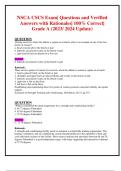Exam (elaborations)
Physical Examination and Health Assessment 9th Edition Test Bank by Carolyn Jarvis, Ann L. Eckhardt
This isn't a book,a test bank is a collection of pre-written exam questions and answers designed to help educators assess and evaluate students' knowledge and understanding of course material. It serves as a valuable resource for creating quizzes and exams, saving instructors time and ensuring...
[Show more]












